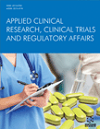- Home
- A-Z Publications
- Applied Clinical Research, Clinical Trials and Regulatory Affairs
- Previous Issues
- Volume 5, Issue 2, 2018
Applied Clinical Research, Clinical Trials and Regulatory Affairs - Volume 5, Issue 2, 2018
Volume 5, Issue 2, 2018
-
-
Regulatory Approval of Silver Nanoparticles
More LessAuthors: Richa Sood and Dimple S. ChopraAdvances in nanotechnology are being applied in the development of novel therapeutics that may address several shortcomings of conventional small molecule drugs and may facilitate the realization of personalized medicine. Interestingly, nanoparticle drug candidates often represent multiplexed formulations (e.g. drug, targeting moiety, and nanoparticle scaffold material). By tailoring the chemistry and identity of vari Read More
-
-
-
Drug Development Process and Novel Drugs Approved by FDA for 2017-18
More LessAuthors: Gaurav Khurana, Aashu Rohilla and Aakash DeepDelivering authentic healthcare Innovation worldwide is a demanding and complex task. The global discovery and approval of new drugs, medical devices and biologics will revolutionize the availability of health care products worldwide. The mission of pharmaceutical research companies is to discover and develop new drugs with safe and effective treatment to patients. Drug development is a science-driven process that at its Read More
-
-
-
Regulatory Concerns for Nanomaterials in Sunscreen Formulations
More LessAuthors: Kamla Pathak, Satyanarayan Pattnaik and Amit PorwalBackground: There has been a phenomenal rise in the nanomaterial-based cosmetic formulations in the market, raising serious concerns over the possible biological impact on humans, animals and the environment as a whole. However, scarce reports can be found on the safety assessment of nanomaterials incorporated in cosmetic formulations including sunscreens. Hence, uncertainties loom for their safe use in cosmetics inc Read More
-
-
-
Nanotechnology Driven Cosmetic Products: Commercial and Regulatory Milestones
More LessAuthors: Madan Kumud and Nanda SanjuBackground: Nanotechnology has found manifold applications in both medicine and cosmetics. It has lead to various beauty solutions by innovating products with nanoparticles or nanocolloidal carriers that can go deeper below the skin surface to give better results. This technology has been used in skin care formulations like sunscreens, antiaging creams, etc. Many natural sunscreen agents (Retinol and Vitamin E) and physic Read More
-
-
-
Nano-Oncologicals: Regulatory Aspects and Safety Issues
More LessAuthors: Jasjeet K. Narang, R.S. Narang, Deepti Pandita, Viney Lather and Anmol DograBackground: Nanotechnology has touched almost all the spheres of life and all fields of science globally. It has become a part of everyday routine. Many nanoproducts have already reached the market. Over the last decade extensive research has been done to develop nanomedicines for prevention, diagnosis and treatment of various ailments. The reduced side effects associated with the targeted delivery of nanotherape Read More
-
-
-
Recent Updates on Nanomedicine Based Products: Current Scenario and Future Opportunities
More LessBackground: Nanomedicine, defined as the application of nanotechnology for the prevention, cure and diagnosis of diseases, has emerged as one of the most exciting tools in the medical field for direct benefit to human health. Nanomedicine aims to engineer the materials at nanoscale to develop new drugs, delivery systems in a way to mimic or understand the cellular processes at molecular level for therapeutics of disea Read More
-
Most Read This Month
Article
content/journals/acctra
Journal
10
5
false
en

Most Cited Most Cited RSS feed
-
-
-
A Rapid LC-ESI-MS/MS Method for the Quantitation of Salicylic Acid, an Active Metabolite of Acetylsalicylic Acid: Application to in vivo Pharmacokinetic and Bioequivalence Study in Indian Healthy Male Volunteers
Authors: Dhiman Halder, Shubhasis Dan, Easha Biswas, Pradipta Sarkar, Umesh C. Halder and Tapan K. Pal
-
- More Less

